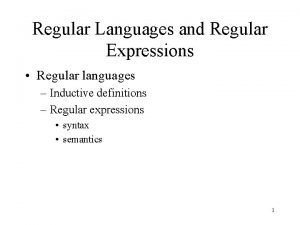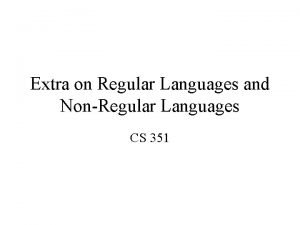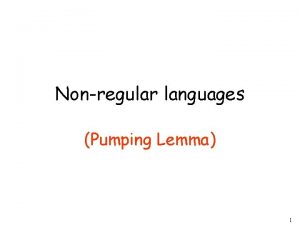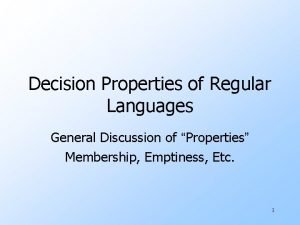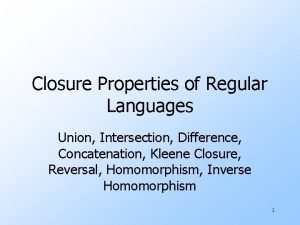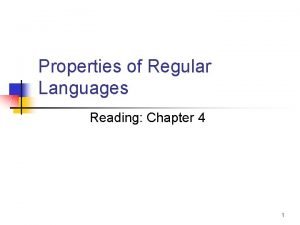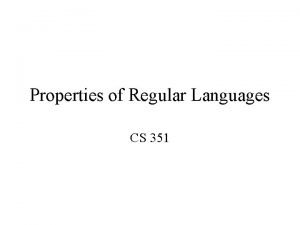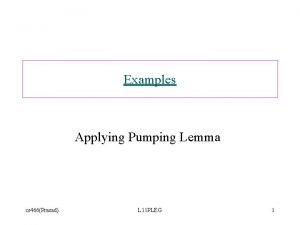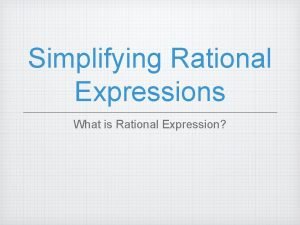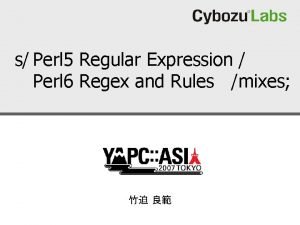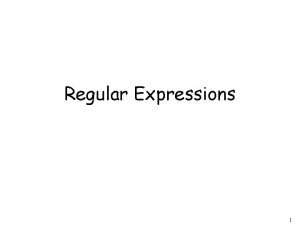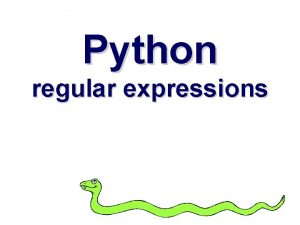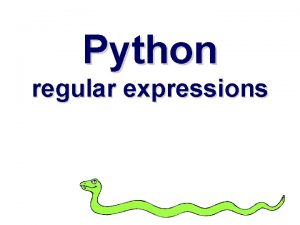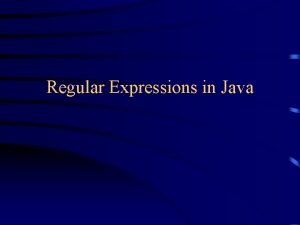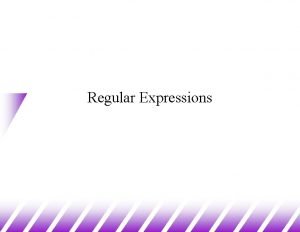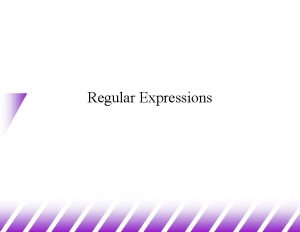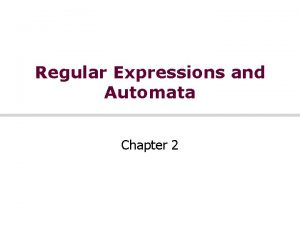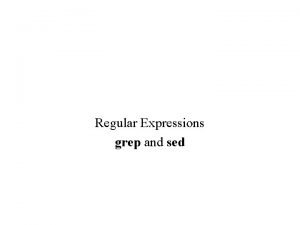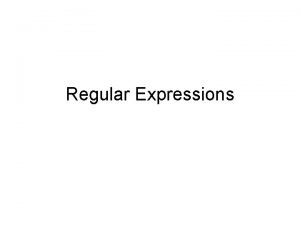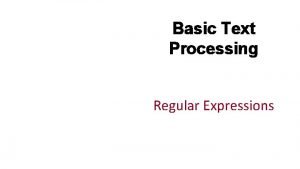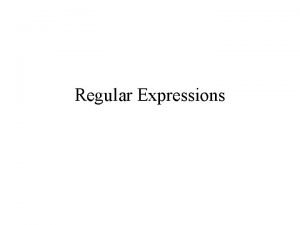Regular Languages and Regular Expressions Regular languages Inductive














- Slides: 14

Regular Languages and Regular Expressions • Regular languages – Inductive definitions – Regular expressions • syntax • semantics 1

Regular Languages (Regular Expressions) 2

Regular Languages • New language class – Elements are languages • We will show that this language class is identical to LFSA – Language class to be defined by Finite State Automata (FSA) – Once we have shown this, we will use the term “regular languages” to refer to this language class 3

Inductive Definition of Integers * • Base case definition – 0 is an integer • Inductive case definition – If x is an integer, then • x+1 is an integer • x-1 is an integer • Completeness – Only numbers generated using the above rules are integers 4

Inductive Definition of Regular Languages • Base case definition – – Let S denote the alphabet {} is a regular language {l} is a regular language {a} is a regular language for any character a in S • Inductive case definition – If L 1 and L 2 are regular languages, then • L 1 union L 2 is a regular language • L 1 concatenate L 2 is a regular language • L 1* is a regular language • Completeness – Only languages generated using above rules are regular languages 5

Proving a language is regular * • Prove that {aa, bb} is a regular language – {a} and {b} are regular languages • base case of definition – {aa} = {a}{a} is a regular language • concatenation rule – {bb} = {b}{b} is a regular language • concatenation rule – {aa, bb} = {aa} union {bb} is a regular language • union rule • Typically, we will not go through this process to prove a language is regular 6

Regular Expressions • How do we describe a regular language? – Use set notation • {aa, bb, ab, ba}* • {a}{a, b}*{b} – Use regular expressions R • Inductive def of regular languages and regular expressions on page 72 • (aa+bb+ab+ba)* • a(a+b)*b 7

R and L(R) * • How we interpret a regular expression – What does a regular expression R mean to us? • aaba represents the regular language {aaba} • f represents the regular language {} • aa+bb represents the regular language {aa, bb} – We use L(R) to denote the regular language represented by regular expression R. 8

Precedence rules • What is L(ab+c*)? – Possible answers: • • {a}({b} union {c}*} ({a}{b, c})* ({ab} union {c})* {ab} union {c}* – Must know precedence rules • * first, then concatenation, then + 9

Precedence rules continued • Precedence rules similar to those for arithmetic expressions – ab+c 2 • (a times b) + (c times c) • exponentiation first, then multiplication, then addition • Think of Kleene closure as exponentiation, concatenation as multiplication, and union as addition and the precedence rules are identical 10

Regular expressions are strings * • Let L be a regular language over the alphabet S – A regular expression R for L is just a string over the alphabet S union {(, ), +, *, f, l}. – The set of legal regular expressions is itself a language over the alphabet S union {(, ), +, *} • f, a*aba are strings in the language of legal reg. exp. • )(, *a* are strings NOT in the language of legal reg. exp. 11

Semantics * • We give a regular expression R meaning when we interpret it to represent L(R). – aaba is just a string – we interpret it to represent the language {aaba}. • We do similar things with arithmetic expressions – 10+72 is just a string – We interpret this string to represent the number 59 12

Key fact * • A language L is a regular language iff there exists a reg. exp. R such that L(R) = L – When I ask for a proof that a language L is regular, rather than going through the inductive proof we saw earlier, I expect you to give me a regular expression R s. t. L(R) = L 13

Summary • Regular expressions are strings – syntax for legal regular expressions – semantics for interpreting regular expressions • Regular languages are a new language class – A language L is regular iff there exists a regular expression R s. t. L(R) = L • We will show that the regular languages are identical to LFSA 14
 Regular language
Regular language Which grammar generates regular language
Which grammar generates regular language Regular and irregular languages
Regular and irregular languages Pumping lemma non regular languages examples
Pumping lemma non regular languages examples Decision properties of regular languages
Decision properties of regular languages Decision properties of regular language
Decision properties of regular language Regular languages closure properties
Regular languages closure properties Decision properties of regular languages
Decision properties of regular languages Decision properties of regular languages
Decision properties of regular languages Properties of regular languages
Properties of regular languages Contradict example
Contradict example Right linear grammar
Right linear grammar Xkcd regular expressions
Xkcd regular expressions Simplify expressions examples
Simplify expressions examples Perl 5 regular expression
Perl 5 regular expression
